Saturday, October 01, 2005
Grand Challenge NQE update.
 The National Qualifying Event results are being published on the Grand Challenge website as we speak.
The National Qualifying Event results are being published on the Grand Challenge website as we speak.The NQE test track consists of several obstacles. The course layout is shown above. The course includes four major obstacles which must be navigated and 50 gates, each of which should be passed through. Finishing bots are ranked based on how many gates they passed correctly, with time deciding any ties in number of gates.
The gold standard right now is held by the Stanford Racing Team, who navigated all four obstacles and cleared all 50 gates in 10 minutes and 31 seconds. In second place is Team Cornell, with 49 gates cleared in 10 minutes 41 seconds. Right now 33 teams have posted a number of passed gates and only 11 have finished, so there are 22 DNFs (did not finish) right now. I don't know if a second run will be performed to thin (or thicken) the ranks to 20, or if they will simply let the DNFs with the most gates advance to fill the remaining slots.
I believe the first run is still underway since there are 8 vehicles listed as DNF with no stats, so I am assuming that those vehicles haven't taken their first run yet. It is possible though that all 8 failed at the starting gate.
The top ten in the rankings right now are:
- The Stanford Racing Team
- Team Cornell
- Desert Buckeyes
- Princeton University
- Mojávaton
- Red Team Too
- Red Team
- CIMAR
- Team TerraMax
- Intelligent Vehicle Safety Technologies
I couldn't find a web presence for every team. In the case of the Princeton U team and the IVST team I've simply linked to their Darpa Grand Challenge team info page.
Friday, September 30, 2005
Murata Boy
EE Times is reporting that Murata Manufacturing Co. has a robotic bicycle rider.
Murata, better known as a component manufacturer for everything from discrete components like resistors and capacitors up to spherical speakers, has manufactured the system as a vehicle for pimping their wide array of sensors. The miniature example was in preparation for the demonstration that is planned for the CEATEC Japan 2005 show next week. The story says that the robot can start and stop under its own power, and maintain a forward velocity of about 2 kilometers per hour. It won't be challenging Lance anytime soon, but it is a pretty impressive start.
If anybody has a picture of this thing, send it my way.
Murata, better known as a component manufacturer for everything from discrete components like resistors and capacitors up to spherical speakers, has manufactured the system as a vehicle for pimping their wide array of sensors. The miniature example was in preparation for the demonstration that is planned for the CEATEC Japan 2005 show next week. The story says that the robot can start and stop under its own power, and maintain a forward velocity of about 2 kilometers per hour. It won't be challenging Lance anytime soon, but it is a pretty impressive start.
If anybody has a picture of this thing, send it my way.
Robot Village
 News 8 of Austin Texas has a blurb about Robot Village in Manhattan.
News 8 of Austin Texas has a blurb about Robot Village in Manhattan.Robot village is a complete store and education center on West 81st street, just off Broadway in New York City. They just launched recently and their website still has several sections marked "coming soon". The concept of an entire polished retail store in NYC is pretty cool. While online retailers are all well and good, the idea of a physical storefront with workbenches for classes, robot rental offers, and an entire book and magazine section is encouraging.
Let's hope they do well, and if you are in the Manhattan area, be sure to stop by.
[Editor's note: no, I have no idea why the opening of a robot store in Manhattan is important to Austin Texans]
Robots in Combat
 File Under: RHFI machines.
File Under: RHFI machines.The Decatur Daily has a neat little article about combat robotics in the military. It focuses on the work of Col. Edward M. Ward, a marine stationed at Redstone arsenal with the Robotic Systems Joint Project Office. Colonel Ward helps plan the daily use of Remote Human Feedback Input Machines ("Robots" to the rest of you) in the military.
The article outlines the costs and uses of some of the robots currently deployed in Iraq and Afghanistan, including the tiny Throwbot, iRobot's packbot, and others.
The Scope of this Blog
As an editor of a blog focusing on Robotics news, and a roboticist with firm personal views about what defines a robot, I'm torn about how to choose stories.
For now I'm covering about three major stories a day, and that will probably increase to four or five by the end of the year. Hopefully we'll see more development in this sector until we need multiple editors and bloggers just to keep up with it all.
However I'm torn about what to report. Much of the mainstream media consistently run "robot" stories in which no real "robots" are mentioned.
In short, my problem is this: An electromechanical device that relays data to a remote-control station and receives 100% of it's command input from a human at that station is not a robot. The media doesn't understand this. Sometimes it seems that any device that moves under electrical power is called "robot" even in the absence of any decision making ability.
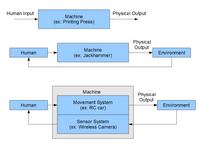 I have created a set of diagrams that should make clear my distinction between a robot and a machine. This first image is a diagram of the three types of machines, which I call open-loop-human-input (OLHI) machines, human-feedback-input machines (HFI), and remote-human-feedback-input (RHFI) machines.
I have created a set of diagrams that should make clear my distinction between a robot and a machine. This first image is a diagram of the three types of machines, which I call open-loop-human-input (OLHI) machines, human-feedback-input machines (HFI), and remote-human-feedback-input (RHFI) machines.
The media often refers to certain instances of these last two classes as "robots" despite their inability to make their own decisions.
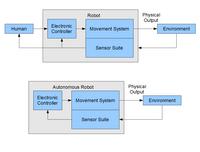 These are contrasted with two types of robots, standard robots which might receive direct electronic commands from humans but also make basic decisions independently or in cooperation with their users, and autonomous robots, where the human is part of the environment and all human input comes through the sensor suite--like any other input.
These are contrasted with two types of robots, standard robots which might receive direct electronic commands from humans but also make basic decisions independently or in cooperation with their users, and autonomous robots, where the human is part of the environment and all human input comes through the sensor suite--like any other input.
For the time being, Rossum's Children will continue to cover robots, autonomous robots, and HFI and RHFI machines, due to their prominent place as part of the 'robotics' community. Certainly the tasks these machines carry out are no less noble than those of their more autonomous brethren, and their development has resulted in many improvements in the technology of the sensors and actuators that are also used on robots.
However, as the robotics industry grows and news becomes more abundant, expect to see fewer and fewer HFI/RHFI stories.
For now I'm covering about three major stories a day, and that will probably increase to four or five by the end of the year. Hopefully we'll see more development in this sector until we need multiple editors and bloggers just to keep up with it all.
However I'm torn about what to report. Much of the mainstream media consistently run "robot" stories in which no real "robots" are mentioned.
In short, my problem is this: An electromechanical device that relays data to a remote-control station and receives 100% of it's command input from a human at that station is not a robot. The media doesn't understand this. Sometimes it seems that any device that moves under electrical power is called "robot" even in the absence of any decision making ability.
 I have created a set of diagrams that should make clear my distinction between a robot and a machine. This first image is a diagram of the three types of machines, which I call open-loop-human-input (OLHI) machines, human-feedback-input machines (HFI), and remote-human-feedback-input (RHFI) machines.
I have created a set of diagrams that should make clear my distinction between a robot and a machine. This first image is a diagram of the three types of machines, which I call open-loop-human-input (OLHI) machines, human-feedback-input machines (HFI), and remote-human-feedback-input (RHFI) machines.The media often refers to certain instances of these last two classes as "robots" despite their inability to make their own decisions.
 These are contrasted with two types of robots, standard robots which might receive direct electronic commands from humans but also make basic decisions independently or in cooperation with their users, and autonomous robots, where the human is part of the environment and all human input comes through the sensor suite--like any other input.
These are contrasted with two types of robots, standard robots which might receive direct electronic commands from humans but also make basic decisions independently or in cooperation with their users, and autonomous robots, where the human is part of the environment and all human input comes through the sensor suite--like any other input.For the time being, Rossum's Children will continue to cover robots, autonomous robots, and HFI and RHFI machines, due to their prominent place as part of the 'robotics' community. Certainly the tasks these machines carry out are no less noble than those of their more autonomous brethren, and their development has resulted in many improvements in the technology of the sensors and actuators that are also used on robots.
However, as the robotics industry grows and news becomes more abundant, expect to see fewer and fewer HFI/RHFI stories.
Thursday, September 29, 2005
New Sony Dogs Blog? Old Dogs Lost in Fog?
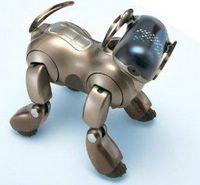 The new Aibo ERS-7M3 is here (link goes to Japanese Language product page--an English press release is also available).
The new Aibo ERS-7M3 is here (link goes to Japanese Language product page--an English press release is also available).The upgrade is based on the new "Mind-3" software. And it has provided Aibo with a few new tricks. He's increased his potential vocabulary to over 1,000 words, and the complexity of the words he can understand has been enhanced as well.
Perhaps the most interesting new feature is the Aibo "diary." From what I can tell from the confusing and sometimes hilarious Google translation of the Sony product page, Aibo now keeps a journal and photoblog that you can access with a software system via your home computer. This may even mean that you can open a gateway that lets your dog blog directly onto the internet.
Just think of it! Your dog could blog about his day! Wonderful! He'll write long eloquent posts about how you never play with him anymore, and his eyesight seems to be failing because he can't find that stupid pink ball. He can post stories about how the dachsund next door snubbed him and he will never find true love again. Maybe he'll even add an entry about that time he accidentally walked in on your getting to second base with that girl from the coffee shop! With photos! Won't mom be proud!
All joking aside, the new system has some serious upgrades, and Aibo's ability to read RSS feeds and news to you, understand a whole lot more commands, and provide better feedback on current emotional state and mood are nothing to sneeze at. This little pup will be staying king-of-the-hill for electronic pets for some time yet.
Selling price is 194.25 thousand Yen, or roughly US $1715, so start saving now.
(Best Engrish quote from the translated product page is "Pattern of the ear and the tail differs every individual, is warm it is the commodity which adopts the color taste which is the straw raincoat.")
Special thank you to Akihabara News for the heads up.
Kurzweil Interview
 An interview with the enigmatic and often quirky future-predicting Ray Kurzweil has just gone up on Cnet's News.com. It is about his new book, The Singularity Is Near.
An interview with the enigmatic and often quirky future-predicting Ray Kurzweil has just gone up on Cnet's News.com. It is about his new book, The Singularity Is Near.I was required to read The Age of Spiritual Machines back in my undergrad AI course, and found it entertaining but a bit overly-fantastic. I don't argue that Ray's other predictions about the future have been pretty spot on (chess playing robots, et all). However, I found Rodney Brooks' more reasonable and short term forecasts from Flesh and Machines much easier to swallow.
I also thought Brooks' "Immortality is a Dead Idea" point was a strong one, and it is a place where I think Kurzweil is reaching too far, too fast, because he plans to live forever, Woody Allen style.
In any case, the interview is an interesting read. The interviewer doesn't seem too interested in pulling punches. It's good to see a skeptic take the initiative and ask the hard questions.
Image Mash-up Courtesy of GIMP.
New Driverless London Bus Proposal
File Under: Transport.
The London Times is reporting that London might have driverless buses in the near future.
The article is short but promising, outlining a rosy future with small 24 passenger capacity buses acting like large taxis with flexible routing and the ability to be summoned via a mobile phone message.
The proposal claims that it will have a couple of prototype buses by 2007, and the project leader has hinted that the perfect showcase for this system would be the Olympic games in 2012.
The London Times is reporting that London might have driverless buses in the near future.
The article is short but promising, outlining a rosy future with small 24 passenger capacity buses acting like large taxis with flexible routing and the ability to be summoned via a mobile phone message.
The proposal claims that it will have a couple of prototype buses by 2007, and the project leader has hinted that the perfect showcase for this system would be the Olympic games in 2012.
Wednesday, September 28, 2005
Enon: Is this the best the industry can do?
 I just ran across an associated press article (reprinted here in the Fort Wayne Journal Gazette) about Fujitsu's latest robot offering.
I just ran across an associated press article (reprinted here in the Fort Wayne Journal Gazette) about Fujitsu's latest robot offering.The robot in question is intended to guide people around stores, assisting them in finding what they are looking for and helping out. The need is especially great in Japan, where the so-called "silver age" is rapidly approaching as more and more of the workforce retires. Robots that handle simple tasks like this will free up the shrinking workforce to handle more complex interactions than "where is the restroom" and "do you sell rugs?", which is a good thing.
However this article disturbs me. The article states that the offering price for this robot is US$54,000 for the hardware. It seems that the software is extra, and Fujitsu refuses to even provide estimates.
Now Enon isn't a crappy robot by any stretch. He's got some very cool abilities and some very intelligent design features. but we're talking about a 4 foot tall wheeled robot with two 'paws' that can lift a tiny bit more than a pound. Each arm provides 5 degrees of freedom (for reference: the human arm has 7 degrees of freedom, but the hand contains an additional 14 joints to provide dexterity, none of which Enon possesses).
I guess I am just surprised that the opening price here is $54,000. That seems high for the amount of technology (sans software) involved in this robot. I do note that Fujitsu hopes to drive the price down to $18k if they go to full scale production though, which is encouraging.
For more information on Enon, check out Fujitsu's full press release.
Tuesday, September 27, 2005
DARPA Grand Challenge National Qualification Event Starts Today.
 The Darpa Grand Challenge, in which autonomous robots compete to see who can traverse an unspecified track in the desert the fastest, is warming up.
The Darpa Grand Challenge, in which autonomous robots compete to see who can traverse an unspecified track in the desert the fastest, is warming up.The Defense Advanced Research Projects Agency's competition is designed to draw out skilled robotics teams to build an autonomous vehicle that can manage difficult terrain and navigate on its own through harsh environments. Last year's grand challenge had a purse of US $1 million and no winner. Fifteen vehicles competed for the prize and none were successful.
This year the purse has been doubled and the site is in the desert and mountains near Primm Nevada, the exact route will not be revealed until 2 hours before the race begins on October 8th. There were 195 applicants this year and as of September 14th the field has been narrowed to 43 semifinalists. These semifinalists will face off in the National Qualification Event this week in Fontana California and the top twenty will go on to compete in the national event next month.
The 2005 DARPA grand challenge website contains complete rules and information as well as press releases about the event.
We are told that tracking information will be available from GrandChallenge.org during the race.
Update
A few of the teams have been featured in the news today. For your enjoyment:
- The OC Register has an article about Team Cyberrider.
- MercuryNews.com has a piece on Team Underdawg.
Little Arturito Camera Shy.
Arturito, the robot featured in yesterday's treasure story is turning out to be pretty camera shy.
This is one of the only images I've been able to dig up of the little fellow.
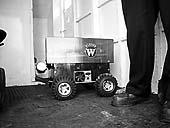 Arturito means "little Arthur" in Spanish, and is the name commonly used to refer to the Star Wars character R2-D2. According to the scattered news I've been able to collect, Arturito performs sub-surface scanning using a variety of techniques to determine soil composition up to 50m below him. Pretty impressive for something that appears not much larger than your average pit bull.
Arturito means "little Arthur" in Spanish, and is the name commonly used to refer to the Star Wars character R2-D2. According to the scattered news I've been able to collect, Arturito performs sub-surface scanning using a variety of techniques to determine soil composition up to 50m below him. Pretty impressive for something that appears not much larger than your average pit bull.
The story so far has unfolded like a sequel to National Treasure with the addition of a robot cast member. The bad news for Arturito's owners--the elusive and seemingly web-presence-less Wagner Technologies--and the private investor Bernard Keiser--who has been hunting this cache since 1998--is that it looks like both the Chilean government and the owners of the island are making a grab for the cash. We'll see how it works out. Hopefully Wagner Technologies will at least be compensated with a healthy finder's fee.
If anybody has a better image of Arturito, or more information about him, feel free to drop me a line.
This is one of the only images I've been able to dig up of the little fellow.
 Arturito means "little Arthur" in Spanish, and is the name commonly used to refer to the Star Wars character R2-D2. According to the scattered news I've been able to collect, Arturito performs sub-surface scanning using a variety of techniques to determine soil composition up to 50m below him. Pretty impressive for something that appears not much larger than your average pit bull.
Arturito means "little Arthur" in Spanish, and is the name commonly used to refer to the Star Wars character R2-D2. According to the scattered news I've been able to collect, Arturito performs sub-surface scanning using a variety of techniques to determine soil composition up to 50m below him. Pretty impressive for something that appears not much larger than your average pit bull.The story so far has unfolded like a sequel to National Treasure with the addition of a robot cast member. The bad news for Arturito's owners--the elusive and seemingly web-presence-less Wagner Technologies--and the private investor Bernard Keiser--who has been hunting this cache since 1998--is that it looks like both the Chilean government and the owners of the island are making a grab for the cash. We'll see how it works out. Hopefully Wagner Technologies will at least be compensated with a healthy finder's fee.
If anybody has a better image of Arturito, or more information about him, feel free to drop me a line.
Monday, September 26, 2005
The 2005 IRVS
For those of you in the Chicago Area, the 2005 International Robots & Vision Show and Conference is this week. The convention started today, and the show starts tomorrow and runs through the 29th. It should be a great show, and several exciting new robots will be guests there, including Gecko System's Carebot MSR 3.4 and Nasa's Robonaut.
The IRVS focuses around all aspects of the Machine Vision industry, ranging from mobile robots to stationary systems. Sadly, I just found out about it today (what rock have I been under?) and won't be able to attend this year. Hopefully two years from now I'll be able to give you coverage live from the convention floor.
If you do decide to drop by, make sure to check out this web site because it seems that if you register today admission is free. At the door tomorrow tickets will be $30.
The IRVS focuses around all aspects of the Machine Vision industry, ranging from mobile robots to stationary systems. Sadly, I just found out about it today (what rock have I been under?) and won't be able to attend this year. Hopefully two years from now I'll be able to give you coverage live from the convention floor.
If you do decide to drop by, make sure to check out this web site because it seems that if you register today admission is free. At the door tomorrow tickets will be $30.
Arturito finds sunken Treasure.
One of our fine electronic friends may have just made a 10 billion dollar haul.
The robot, named "Arturito" (Little Arthur) found an 18th buried treasure on the island of Robinson Cruseo, named after Defoe's famous novel.
The discovery has not yet been dug up, and the Chilean government might claim the entire prize for themselves. Sadly, no decent picture of Arturito has materialized yet.
The robot, named "Arturito" (Little Arthur) found an 18th buried treasure on the island of Robinson Cruseo, named after Defoe's famous novel.
The discovery has not yet been dug up, and the Chilean government might claim the entire prize for themselves. Sadly, no decent picture of Arturito has materialized yet.
WTEC: "Robotics In US Underfunded." (Wired News)
The World Technology Evaluation Center presented the findings from their Study on International R&D in robotics.
 Delivering the presentation was the ancient fellow you see here, Dr. George A. Bekey of USC. Dr. Bekey spoke briefly on how robot funding is being handled in several key sectors including space exploration, medical applications and transportation. His talk included discussion of American funding policy. The lecture is dry and the presentation slides are terrible (at times, downright illegible), but the information is probably worth observing for anyone interested in this industry in a serious capacity.
Delivering the presentation was the ancient fellow you see here, Dr. George A. Bekey of USC. Dr. Bekey spoke briefly on how robot funding is being handled in several key sectors including space exploration, medical applications and transportation. His talk included discussion of American funding policy. The lecture is dry and the presentation slides are terrible (at times, downright illegible), but the information is probably worth observing for anyone interested in this industry in a serious capacity.
A layman's discussion of the presentation's meaning can be found in the Wired News Article about the event, but if you prefer to know the whole story, the full presentation is available as well.
I find it disappointing to see robotics underfunded in the country most people think of as the birthplace of modern computing. Hopefully we'll see more investors with patience who are willing to take the risk on robot projects and see their rewards in five to ten years.
One thing that was telling about the presentation was the complete lack of industry involvement. It was a six man panel made up of four academics and two government men from NASA. Don't get me wrong--these men are brilliant roboticists. Vijay Kumar's work alone is intimidatingly comprehensive. All of them have distinguished and impressive careers in this industry. But at the end of the day none of them manage businesses that sell robots. I guess it was too much trouble to get Rodney Brooks or Stephen Jacobsen to attend?
If we want to see a truly meteoric rise in robotic development in the US, we need to get the businesses and the academic institutions talking, instead of ignoring each other.
 Delivering the presentation was the ancient fellow you see here, Dr. George A. Bekey of USC. Dr. Bekey spoke briefly on how robot funding is being handled in several key sectors including space exploration, medical applications and transportation. His talk included discussion of American funding policy. The lecture is dry and the presentation slides are terrible (at times, downright illegible), but the information is probably worth observing for anyone interested in this industry in a serious capacity.
Delivering the presentation was the ancient fellow you see here, Dr. George A. Bekey of USC. Dr. Bekey spoke briefly on how robot funding is being handled in several key sectors including space exploration, medical applications and transportation. His talk included discussion of American funding policy. The lecture is dry and the presentation slides are terrible (at times, downright illegible), but the information is probably worth observing for anyone interested in this industry in a serious capacity.A layman's discussion of the presentation's meaning can be found in the Wired News Article about the event, but if you prefer to know the whole story, the full presentation is available as well.
I find it disappointing to see robotics underfunded in the country most people think of as the birthplace of modern computing. Hopefully we'll see more investors with patience who are willing to take the risk on robot projects and see their rewards in five to ten years.
One thing that was telling about the presentation was the complete lack of industry involvement. It was a six man panel made up of four academics and two government men from NASA. Don't get me wrong--these men are brilliant roboticists. Vijay Kumar's work alone is intimidatingly comprehensive. All of them have distinguished and impressive careers in this industry. But at the end of the day none of them manage businesses that sell robots. I guess it was too much trouble to get Rodney Brooks or Stephen Jacobsen to attend?
If we want to see a truly meteoric rise in robotic development in the US, we need to get the businesses and the academic institutions talking, instead of ignoring each other.
Sunday, September 25, 2005
We're back online.
After a rather long delay while I got some things in order, Rossum's Children is going live.
Terms: Minimum of one post per day, six days a week. Every post will deal with some aspect of robot news, be it industry/academic research, hobbyist groups, convention proceedings, or robots in entertainment.
What you see here is the Beta version running through Blogger's rather vanilla layout and template.
Frankly, it's terrible. But it will do while I build up the archives and begin daily news reporting.
Expect to see it undergo some major changes while I add things like a link bar and an about section, and work over the color scheme and layout a bit.
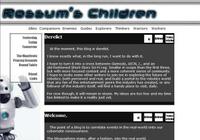 And sometime this fall (maybe within a few weeks if I'm extraordinarily lucky) the real Rossum's children site should go live, with a layout that looks a great deal better (the teaser to the right is one of the potential layouts I'm considering).
And sometime this fall (maybe within a few weeks if I'm extraordinarily lucky) the real Rossum's children site should go live, with a layout that looks a great deal better (the teaser to the right is one of the potential layouts I'm considering).
For now, I'm afraid you'll have to deal with this alpha build.
Terms: Minimum of one post per day, six days a week. Every post will deal with some aspect of robot news, be it industry/academic research, hobbyist groups, convention proceedings, or robots in entertainment.
What you see here is the Beta version running through Blogger's rather vanilla layout and template.
Frankly, it's terrible. But it will do while I build up the archives and begin daily news reporting.
Expect to see it undergo some major changes while I add things like a link bar and an about section, and work over the color scheme and layout a bit.
 And sometime this fall (maybe within a few weeks if I'm extraordinarily lucky) the real Rossum's children site should go live, with a layout that looks a great deal better (the teaser to the right is one of the potential layouts I'm considering).
And sometime this fall (maybe within a few weeks if I'm extraordinarily lucky) the real Rossum's children site should go live, with a layout that looks a great deal better (the teaser to the right is one of the potential layouts I'm considering).For now, I'm afraid you'll have to deal with this alpha build.